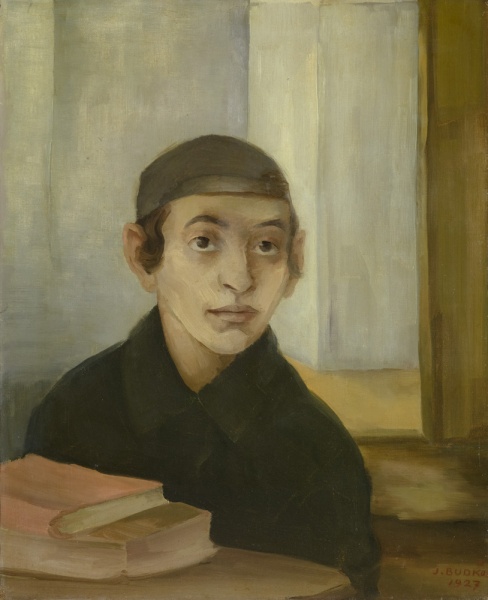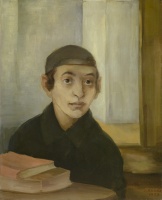
The Jewish boy
| Author: | Joseph Budko (1888–1940) |
Joseph Budko (b. 1888 Płock, Poland – d. 1940 Jerusalem) grew up in a religious Hasidic family. Although his father disapproved of his son’s artistic ambitions, the 14-year-old boy managed to leave home for Vilnius. Between 1902 and 1909 he studied at the Vilnius School of Drawing, briefly went to Warsaw, and later to Berlin. In 1933, when the Nazis came to power in Germany, he fled to Palestine. Budko settled in Jerusalem, and from 1935 to 1940 he worked as director of the Bezalel School of Arts and Crafts, taught graphic art, and laid the foundations for Zionist art. He combined his personal Hasidic experience with elements of German Expressionism and memories of his childhood and life in the shtetl in his work. He seldom took part in exhibitions; after his death retrospective exhibitions of his work were organised in 1940 and 1950, and his paintings and graphic art started to be shown in group exhibitions.
Source: Ellex Valiunas (LAWIN until 2015) art album: STORIES OF LITVAK ART (2023). Compiler and author Vilma Gradinskaitė.
Printmaker, painter and teacher. Born in 1888 in Płońsk (Warsaw Governorate), died in 1940 in Jerusalem. From 1902, he studied at the Vilnius Drawing School, and in 1909, took an examination for obtaining a certificate of teacher of drawing. In 1910, he left for Germany. In Berlin, he studied graphic art under Hermann Struck, who later taught at the Bezalel School of Art and Crafts in Jerusalem. In 1933, Budko also moved to Palestine, from 1935 to 1940 was the headmaster of the renewed Bezalel School and taught graphic art there. He created portraits and compositions about Jewish life, and represented solitary figures in interiors. Budko created some illustrations in the lithographic and woodcut technique for the works by Isaac Leib Peretz, Sholem Aleichem, Sholem Asch and others, and illustrated the ritual Hebrew texts Passover Haggadah and the Bible.
Source: Académie de Vilna: Vilniaus piešimo mokykla 1866-1915 / Vilnius drawing school: Exhibition Catalogue, Nacionalinė dailės galerija 2017 m. 4 d. - lapkričio 26 d., compiled by Jolanta Širkaitė, Vilnius: Lietuvos kultūros tyrimų institutas, 2017, p. 110.

Joseph Budko (b. 1888 Płock, Poland – d. 1940 Jerusalem) grew up in a religious Hasidic family. Although his father disapproved of his son’s artistic ambitions, the 14-year-old boy managed to leave home for Vilnius. Between 1902 and 1909 he studied at the Vilnius School of Drawing, briefly went to Warsaw, and later to Berlin. In 1933, when the Nazis came to power in Germany, he fled to Palestine. Budko settled in Jerusalem, and from 1935 to 1940 he worked as director of the Bezalel School of Arts and Crafts, taught graphic art, and laid the foundations for Zionist art. He combined his personal Hasidic experience with elements of German Expressionism and memories of his childhood and life in the shtetl in his work. He seldom took part in exhibitions; after his death retrospective exhibitions of his work were organised in 1940 and 1950, and his paintings and graphic art started to be shown in group exhibitions.
Source: Ellex Valiunas (LAWIN until 2015) art album: STORIES OF LITVAK ART (2023). Compiler and author Vilma Gradinskaitė.
Printmaker, painter and teacher. Born in 1888 in Płońsk (Warsaw Governorate), died in 1940 in Jerusalem. From 1902, he studied at the Vilnius Drawing School, and in 1909, took an examination for obtaining a certificate of teacher of drawing. In 1910, he left for Germany. In Berlin, he studied graphic art under Hermann Struck, who later taught at the Bezalel School of Art and Crafts in Jerusalem. In 1933, Budko also moved to Palestine, from 1935 to 1940 was the headmaster of the renewed Bezalel School and taught graphic art there. He created portraits and compositions about Jewish life, and represented solitary figures in interiors. Budko created some illustrations in the lithographic and woodcut technique for the works by Isaac Leib Peretz, Sholem Aleichem, Sholem Asch and others, and illustrated the ritual Hebrew texts Passover Haggadah and the Bible.
Source: Académie de Vilna: Vilniaus piešimo mokykla 1866-1915 / Vilnius drawing school: Exhibition Catalogue, Nacionalinė dailės galerija 2017 m. 4 d. - lapkričio 26 d., compiled by Jolanta Širkaitė, Vilnius: Lietuvos kultūros tyrimų institutas, 2017, p. 110.






